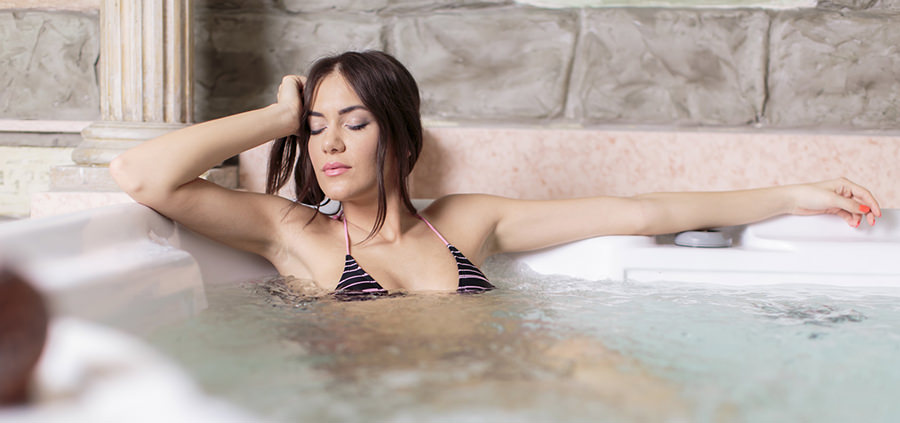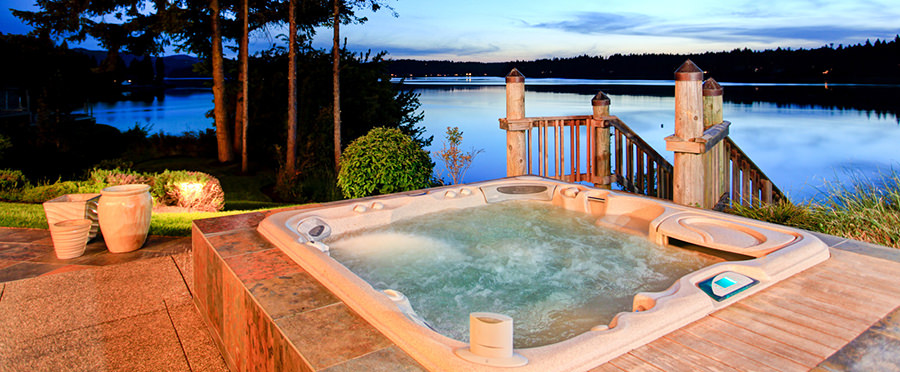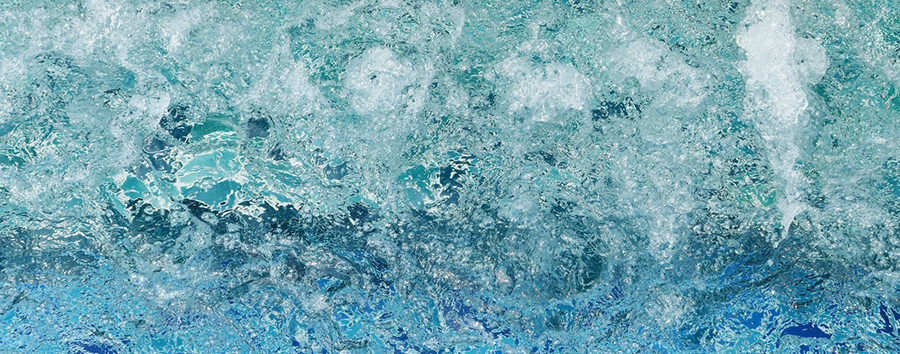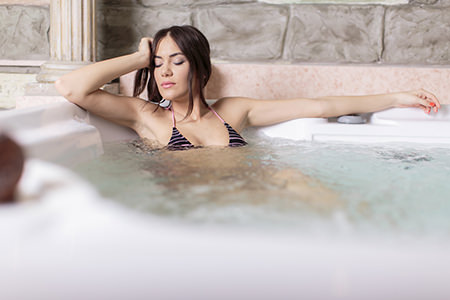
Have you just filled your hot tub for the first time or maybe drained the water out, refilled it and just switched it on? If you have done either of these things, you are probably desperate to jump in for a relaxing soak. However, the problem is that the water hasn’t heated up yet? How long will you have to wait for the water to heat up in your hot tub and how long will it be before you get that well-deserved relaxing soak? As with many things the answer depends on the number of variable factors however, read on to find out how long it might be before your hot tub is fully heated up.
So how long does it take to heat up a hot tub? It can take from anywhere between 4 hours and 20 hours heat up a hot tub. Most hot tubs will heat up water at a rate of between 3 and 6 degrees per hour. The amount of time it takes will depend upon the temperature of the cold water, the efficiency of the hot tub and the quality of the hot tub’s insulation.
Hot tub heating up time?
There’s a wide number of variable factors that will effect how long it takes your hot tub to heat up. We will come to that in a moment but for a start let’s see if we can work out a ballpark figure as to how long you’re going to have to wait for that long relaxing soak.
So, most hot tubs will heat up water at a rate of between 3 and 6 degrees Fahrenheit per hour. I’ve also just found out that the average water temperature for cold water that comes out of a tap/faucet in the USA is around 50 degrees F.
Apparently this doesn’t particularly change with the seasons but it might vary depending upon where exactly your water comes from. The recommended maximum temperature for a hot tub in Fahrenheit is 104 degrees so we are looking for a temperature increase of around 50 degrees Fahrenheit. You can read about the correct temperature for your hot tub here.
If your hot tub is heating up at the lower rate of the average of around 3 degrees per hour then it would take about 16 hours to reach 104 degrees. On the other hand, if your hot tub is more thermally efficient and will heat up more quickly at around 6 degrees Fahrenheit per hour it could only take around 8 hours or so for your water to be up to working temperature. So the short answer is that generally speaking most hot tubs are going to be ready for use in between 8 or 16 hours from switching on.
This can seem like a frustratingly long time if you have just bought your hot tub and you are waiting for it to heat up for the first time for your first soak. They do say that a watched kettle never boils but it might be a good idea to buy a floating thermometer so that you can see the actual rise in temperature.
Many floating thermometers now feedback the temperature to an app on your phone so you can keep a close eye on your hot tub progress remotely. I have to say this sounds cool and there is a good example of one on Amazon here. It has a few mixed reviews though so personally I think I would go for a much simpler model like this.

What factors effect how quickly a hot tub heats up?
Water temperature – One of the biggest factors in working out how long it will take your hot tub to heat up is the starting temperature of the cold water. Obviously, it’s going to make a big difference if the cold water is barely above freezing and it will take many more hours for the hot tub to reach it’s working temperature. Similarly, very warm initial water temperatures will only help and the whole process will take significantly less time.
It would make sense in this sort of situation to consider adding warm water to the hot tub as well. All after all, the hotter the water is when it first goes in, the quicker the hot tub will be able to get up to temperature. There’s nothing wrong with adding warm water to your hot tub but there are a number of issues that you need to be aware of for to be successful.
The first one is that a hot tub is set to automatically switch off if the water in it exceeds 40 degrees centigrade. If you are not careful about adding hot water to your hot tub then you could very easily exceed 40 degrees if you are filling with your household hot water supply and you could potentially damage your hot tub.
Also filling too quickly with hot water can cause problems with the shell blistering with the heat or simply not having enough time to adjust to the new temperature and warping or buckling. It’s highly possible that if you do damage your hot tub adding warm water to it that you would invalidate your warranty.
The other issue with adding warm water is that that you really need to have a filter on the hose between the tap and the hot tub to remove calcium and metals from the water. Even if you don’t have this filter on the hose there is a certain amount of pressure needed to push the water from the tap through the hose and into the hot tub.
This isn’t a problem on a pressurised cold water system but could cause significant damage and problems if you are expecting your hot water system pump to create this amount of pressure. You would also be expecting your system to create a lot of hot water and this might not be particularly economically viable either.
My personal thought is this is a much safer idea to use cold water from the cold tab and to allow the hot tubs naturally heated up in its own time. Then you will know that the hot tub is gradually adjusting to the heat, that it isn’t going to get too hot and damage the hot tub in any way, you will be able to filter the water properly and you will not be worried about any risk of damage to your household hot water system.
You can read much more information about part filling with warm water in my post here.
KW of the heater – Another important factor as to how long it will take for your hot tub to heat up is the power and efficiency of the heater. Heaters power ratings are measured in kilowatts and broadly speaking the higher the kilowatt rating of the heater the more quickly it will heat the water. This means that a 3 kilowatt heating element should, in theory at least, heat up the same amount of water 3 times more quickly than a 1 kilowatt heating element. Of course, this will use more electricity in a shorter amount of time.

Size of the hot tub – It will also take considerably longer to heat up a hot tub with 700 L of water in it then one with only 300 L in it. Obviously, if you also matched a huge 700ml hot tub with a 1 kilowatt heater then it might take significantly longer to heat up than it’s really should do. It’s important that you don’t have a hot tub that is significantly too big for you.
If you have a 5 or 6 seater hot tub and for a majority of the time there is only one or two of you in it, then you are really heating up a huge body of water unnecessarily. Not only does this take a lot of extra time but it also uses a lot of extra energy and environmental impact has to be considered as well.
A well-designed hot tub will have a suitably rated heater to match the water capacity, however, if you are buying a hot tub then you should check to see see what the heater capacity is. You might find that if you are buying a budget model the heating heat capacity is relatively low in comparison with the water capacity whereas on a more high-end model a powerful heater should be supplied.
Insulation – the amount of insulation and the quality of the insulation of the hot tub will also have a huge part to play in not only how quickly it heats up but also how well it retains its heat. Older hot tubs will be poorly insulated by today’s standards and will constantly leak away heat. Not only will this mean that the hot tub will be slower to heat up from cold, it will also use significantly more energy to keep warm on a day to day basis.
If you suspect that your insulation is not up to scratch you can fairly easily upgrade it yourself by spraying foam insulation into any voids on the underside of the hot tub. This has to be carefully done to avoid covering and components or vent holes but should make the hot tub more thermally efficient.
The quality of the hot tub cover – We all know that hot air rises and so it stands to reason that the hot tub cover is one of the most important factors of keeping warm air in and helping your hot tub to speed up in heating up to working temperature.
Depending upon the quality of your hot tub you might find that your cover is of a fairly standard quality and that upgrading it could, over time, save you a great deal of expense in energy costs. An upgraded hot tub cover could also prevent heat escaping whilst your hot tub is heating up and mean that your hot tub is ready more quickly.
Hot tub covers also have a limited lifespan and will need replacing every 5 or 6 years or so. No matter how good quality they are, they do eventually start to soak up moisture from the hot tub and to deteriorate and, once this starts, the thermal efficiency is severely restricted. If you want to avoid some of the common problems and pitfalls when buying a new hot tub cover then have a look at my detailed posted here.
Ambient temperature – The ambient air temperature will also play a part in determining how quickly your hot tub heats up. The same hot tub heating up the same amount of water the same amount in either a very hot or a very cold ambient temperature will take varying amounts of time. There’s not really much you can do about this one, but do bear in mind that if you are heating your hot tub up in the depths of winter it will take significantly longer than it would to do the same thing in 30 or 40 degree sunshine.
Position of the hot tub – In a similar way that the ambient air temperature will affect the heating time, the position of the hot tub could well make a major difference as well. If you have your hot tub in a sheltered spot with walls on two or three sides where the sun is beating down for a majority of the day it will help to heat up the hot tub more quickly. Similarly, a cold spot that is subject to the prevailing wind, or which simply doesn’t catch the sun will be inherently colder and so the hot tub will take longer to heat.

Why does it take so long to heat up a hot tub?
You might imagine that in this technological age it would be possible to do something as simple as heat up a body of water quickly and efficiently. Wouldn’t it be great if your hot tub had a power setting whereby you could heat the water instantly in 10 minutes or so and get from cold to soaking temperature almost immediately!
Sadly this isn’t the case and there are a number of reasons why. Firstly, water is obviously a liquid and liquids do take a certain amount of time to heat up. Water/liquid molecules are all jiggling around together and moving so once a water molecule is warmed it loses its heat really quickly as it bumps into a number of cold molecule surrounding it.
Solids heat in a slightly different way in that the molecules are more tightly packed together and so transfer the heat more efficiently as it gradually travels through the solid mass and heats all of it. Heating any water does take quite a long time, even a kettle of water takes a few minutes to heat to boiling point and heating a pan of water on the hob is a really slow process.
So, in order to heat 700 litres of water in a hot tub very very quickly you would need an immense amount of heat energy. I’m certainly no physicist or expert in this field but I would guess that it is simply not viable or even safe to transfer the huge amount of energy in a short amount of time that would be needed to heat up your hot tub in 10 minutes or so.
The other problem with heating the hot tub up really quickly is that the shell and components won’t have time to gradually adjust to the new temperatures. It’s possible that they are going to be damaged or structural problems might occur where the water was heated up too quickly. It would be also possible for or warping or buckling of the shell to ruin the hot tub permanently.
Finally, I would guess that it would need an electricity supply of industrial proportions to be able to supply the amount of electricity that would be needed to do a super quick heat of a hot tub. Most hot tubs are going to be run from a domestic electricity supply and so this is just not going to be a possibility.
Related Questions:
Do the jets have to be on to heat a hot tub? No, the jets do not have to be on to heat a hot tub. In fact, if you have the jest on it might well mean that your hot tub heats more slowly as you are mixing the water with cold air as well as mixing warm and cold water molecules together making it harder for them to retain their heat. However, if you do have the jets on it will ensure that the water is heated more evenly even if it does take a little bit longer. Possibly the best compromise is to leave the jets off when heating your hot tub and then put them on periodically to even the heat throughout.
Should I leave my hot tub on all of the time? There isn’t a definitive answer to this as it will depend upon how often you use it. If you only soak once a week then it’s probably not going to be economically effective to leave it on all the time. However, if you use the hot tub two or three times a week then leaving it on and at working temperature can be more cost effective.

